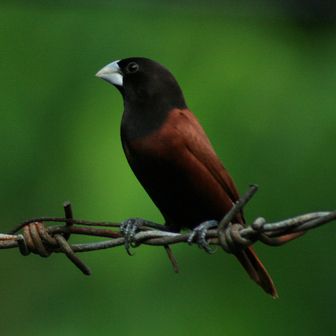Chestnut Munia
The Black-headed Munia has several subspecies that are recognized as followed:

Original source: Lonchura_atricapilla_jagori_-Camiguin_Sur-8.jpg: Heini Wang
Author: Lonchura_atricapilla_jagori_-Camiguin_Sur-8.jpg: Heini Wang
The Chestnut Munia is classified as Least Concern. Does not qualify for a more at risk category. Widespread and abundant taxa are included in this category.
known as Chestnut Munia, is a small passerine bird. This estrildid finch is a resident breeding bird in Bangladesh, Brunei, Cambodia, China, India, Indonesia, Laos, Malaysia, Burma, Nepal, Philippines, Singapore, Taiwan, Thailand, & Vietnam. Known as maya pula ("red maya", to distinguish it from the predominantly brownish Tree Sparrow which is also called maya) in the Philippines, this bird was the former national bird of the Philippines (the Philippine national bird is now the Philippine eagle). More
Chestnut Munia (formerly the National Bird of the Philippines) Scientific name: Lonchura atricapilla Habitat: Ricefields, grasslands and open country. Total length: 109 mm. More
The bird guides say the chestnut munia (Lonchura atricapilla) is easy to find in open country. Clearly the books underestimate their hiding ability, because this is the first time I've seen one for sure. There were actually a whole flock of them, but I could only get one or two on camera. Photobucket This guy isn't as scared as the rest of the flock. More
Chestnut Munias are not as common as the other Munias. They specialise in eating grass seeds and have large conical beaks adapted for this purpose. They feed low among tall grass or on the ground. In Singapore, they are mostly seen in rural areas with tall grass. They are also found in cultivated lands, grasslands, scrub, secondary growth. Gregarious and foraging in flocks, Chestnut Munias are constantly on the move and somewhat nomadic, although they don't migrate. More
Family : Estrildidae
Genus : Lonchura
Species : atricapilla
Authority : (Vieillot, 1807)

